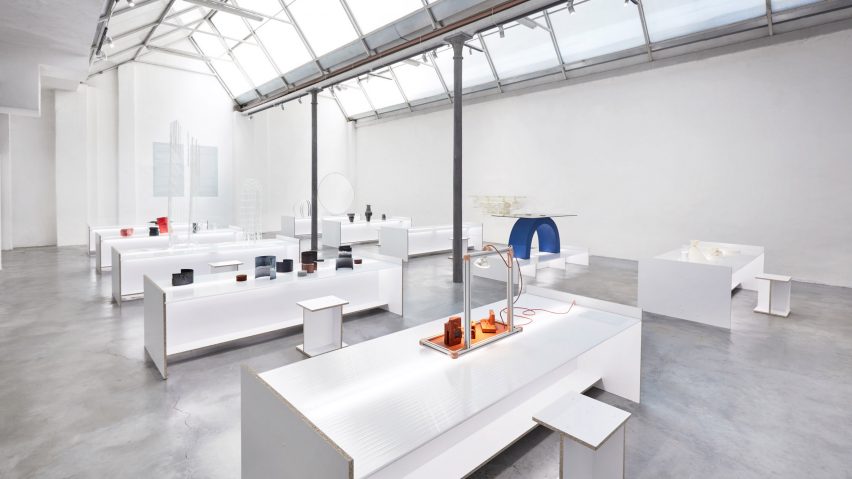Design collective Dutch Invertuals has teamed up with research studio Franklin Till to explore how man-made materials can be "mutated" and repurposed.
The Mutant Matter exhibition, taking place as part of this year's Milan design week, features the work of 10 designers.
Each was asked to each present their vision for how manmade materials that have decayed into the earth's crust, such as plastic, could be mined and used as resources in the future.
The resulting objects include new materials, evaluations of existing ones, and experiments with recycled objects and repurposed waste streams.
"We have entered the Anthropocene era," explained Dutch Invertuals. "This is a new geological age where human making has realigned the processes of nature, forever blurring the boundaries between the natural and the manmade."
The 10 objects are arranged on plinths across exhibition space Spazio O' in Milan's Isola design district.
Design Academy Eindhoven graduate Theophile Blandet's speculative PS sculpture is made from different kinds of non-reusable plastic waste such as polystyrene.
"I aim to celebrate the rarity of plastic in the future, subverting the value of the material," explained Blandet. "Gathering all kinds of waste plastic, I aim to give the material a second chance, elevating trash to create a carefully crafted piece. Presenting plastic as the new ivory, a future forbidden matter and an endangered resource."
Xandra van der Eijk conducted a series of material experiments that examine the processes of corrosion and decay by combining metals with widely available household solutions. The series of objects, called Future Remnants, document the material transformation and the creation of new minerals through decay.
"Future Remnants explores the human influence on the evolutionary development of mineral formation," said Van der Eijk.
"The project aims to convey that the surge in mineral diversity over the past fifty years can be attributed to human activity on the planet, demonstrating how we are altering the earth's geology and raising questions about what will emerge from our actions over time."
First debuted during last year's Dutch Design Week, Israeli designer Shahar Livne showed her Lithoplast project, which sees discarded plastics transformed into a clay-like material, which she envisions as a valuable commodity that future civilisations will mine for.
Presented as a series of altars at Mutant Matter, Lithoplast is created from non-biodegradable plastic, and industrial by-products coal dust and stone. She says the material mimics the geological development of metamorphic rock.
"Whilst historically we depended on earth's natural materials, we are now reliant on human-made matter," said Livne. "This project aims to reconnect us to the natural origins and transformative journeys of our material resources. These altars are the physical juxtaposition of old and new; natural and mutated matter."
Multidisciplinary designer Onno Adriaanse created the Antithesis table as an exploration of what happens when different materials interact and mutate one another.
"The Antithesis Table creates visual tension, combining contradictory states such as fragile and robust, hard and soft, transparent and opaque to create perfect harmony," said Adriaanse.
"By categorising materials and ascribing basic qualities such as soft or fragile we limit our imagination to use and apply them in different ways. "
Inspired by the structure of bone, Mirjam de Bruijn has added air to clay to create a collection of three lightweight ceramic objects that, as a result of being modified with air, can be used for cooling and filtering.
"I found that adding air to a material could not only reduce material usage, but also offer new properties and potential applications," said de Bruijn. "My design process is very much centred around thinking through making, and discovering new potential through the hands-on manipulation of materials."
Other examples include a lamp that combines new material technologies with primitive making techniques, by Thomas Ballouhey, and Fransje Gimbrère's woven architectural sculptures.
As part of the exhibition, London-based design research agency Franklin Till also curated a series of talks exploring our current and future relationship with materials and the role of materiality in design. Called Radical Matters, the series is inspired by the Franklin Till's recently-launched book of the same name.
"Radical Matter inspires us to observe the drastic evolution of materials," said Dutch Invertuals founder Wendy Plomp. "For Milan, we offer our joint vision on a small chapter of this broad and socially involved topic. By envisaging and questioning material innovation we hope to make a real difference on a deeper level."
Caroline Till, Franklin Till founder added: "Geologically speaking, the fruits of the Anthropocene are yet to be witnessed. However, the acceleration of human industry has already made irreversible and permanent changes to the planet, to the point that artificial geological phenomena are being documented worldwide.
"As a result, designers are beginning to consider not only the complications caused by these vast ecological changes, but also the potential," she added.
Mutant Matter marks Dutch Invertuals' 18th appearance at the Salone del Mobile. At last year's exhibition, the Dutch collective asked 10 designers to explore how the human race will tackle future global issues, while in 2016 nine designers created tactile objects designed as physical representations of emotions, beliefs and even galactic phenomena.
Mutant Matter runs until 22 April 2018 at Spazio O' Via Pastrengo 12.
Photography is by Ronald Smits.

